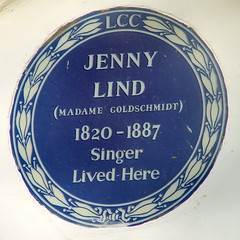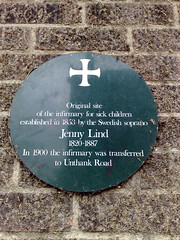Jenny Lind
Commemorated on 4 plaques
Jenny Lind (Madame Goldschmidt) 1820-1887 singer lived here
189 Old Brompton Road, London, United Kingdom where they lived
Original site of the infirmary for sick children established in 1853 by the Swedish soprano Jenny Lind 1820-1887 In 1900 the infirmary was transferred to Unthank Road
Pottergate, Norwich, United Kingdom where they established an infirmary for sick children
The Lion. Dating from before 1618, the premier coaching on the London-Holyhead route. Famous visitors include Charles Dickens, Paganini, William IV, Jenny Lind, D'Quincy, Madame Tussaud, Disraeli. Particular features of note include Adam Ballroom & Tapestry Lounge
Wyle Cop, Shrewsbury, United Kingdom where they stayed
St. Lawrence Hall 1850 St. Lawrence Hall, one of the oldest public buildings in Toronto, was constructed following the Great Fire of 1849 that destroyed a large part of the city's core. Architect William Thomas designed the building in the Renaissance Revival style with Corinthian columns and a domed cupola. The entrance originally led to a shopping arcade connected to the St. Lawrence Market. The building had shops on the main floor and, on the upper floors, offices and a grand meeting hall used for social events and by prominent speakers, performers, and musicians. Abolitionist Frederick Douglass, Swedish soprano Jenny Lind, and showman P. T. Barnum all appeared in the hall, as did William Lyon Mackenzie, Toronto's first mayor and Upper Canada Rebellion leader. In the 20th century, St. Lawrence Hall lost prominence and fell into disrepair. By 1965, it was partially derelict and threatened with demolition. A campaign led by architect Eric Arthur resulted in the restoration of the building and its recognition as a National Historic Site in 1967.
157 King St East, Toronto, ON, Canada where they was




.jpg?width=250)
